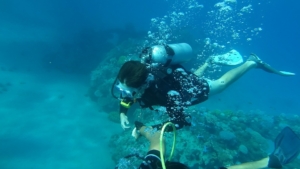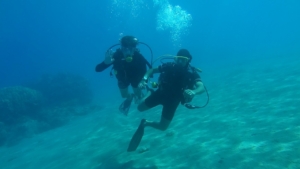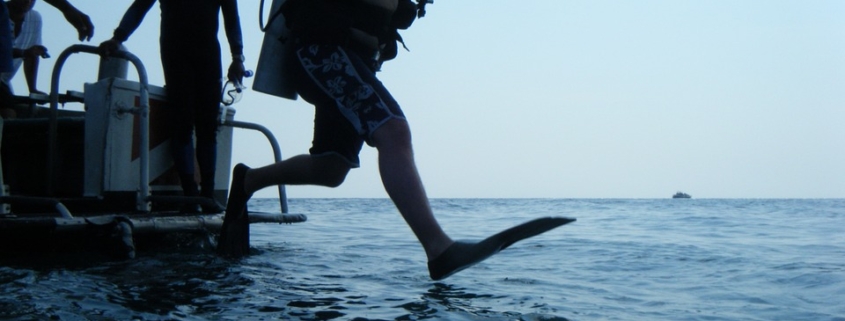When diving, you’ll probably want to bring some personal items like a smartphone, camera, dive log and a fish identification book. Even if you plan on the leaving these items on the boat, though, they may still get wet. Maybe a rogue waved splashed against the boat’s hull and splashed your smartphone with water, or perhaps you or another diver accidentally spilled a drink on your camera. Although it’s not the end of the world, it’s frustrating when your personal items are damaged from water. The good news is that you can still bring your personal items on your diving trips — you just need to take the rig
Don’t Sit Near the Edge of the Boat
 When first stepping onto the charter boat, choose a seat near the center rather the edge of the boat. Depending on where exactly you are diving, as well as the type of charter boat used, it may take an hour or longer to reach your dive site. Some divers prefer sitting on the edge so that they can look out at the ocean. If you sit near the edge of the boat, though, you may get splashed from rogue waves.
When first stepping onto the charter boat, choose a seat near the center rather the edge of the boat. Depending on where exactly you are diving, as well as the type of charter boat used, it may take an hour or longer to reach your dive site. Some divers prefer sitting on the edge so that they can look out at the ocean. If you sit near the edge of the boat, though, you may get splashed from rogue waves.
By sitting near the center of the boat, you are less likely to get splashed. Of course, you won’t always have the luxury of sitting wherever you please. If the charter boat is crowded — or if it doesn’t have center seats — you’ll have to sit near the edge.
Beware of Spilled Beverages
In addition to sitting near the center of the boat, you should use caution when drinking to avoid spilled beverages. Whether you’re drinking soda, iced tea or bottled water, a spilled beverage could damage your personal belongings. Spilling a bottle of water on a smartphone, for example, may destroy the device’s internal circuitry. Granted, some smartphones are waterproof, but most are not. Nonetheless, it’s best to err on the side of caution by avoiding spilled beverages.
Here are some tips to avoid spilled beverages when riding on a charter boat to your dive site:
- If the charter boat has cup holders, use them.
- Keep the top or lid of your beverage closed when you aren’t drinking.
- Avoid drinking out cans, which unfortunately don’t have a resealable top or lid.
- Invest in a spill-proof cup to use specifically for your dive trips.
- Always place beverages on a flat and even surface.
- Secure beverages in place by sandwiching them between towels or other items.
Store Electronics in a Dry Tech Bag
An easy and effective way to protect your electronics from water damage is to store them in a dry tech bag. Like other dry bags, they offer a waterproof component in which you can store small items. Dry tech bags differ, however, in the sense that they are designed specifically for electronics. You can use them to protect your smartphone, tablet, camera, watch and other electronics from water-related damage. Before stepping onto the charter boat, place all your electronics in a dry tech bag.
The Waterproof Dry Tech Bags sold here at Dive Logz not only protects your electronics from water-related damage; they allow you to continue using your electronics. In other words, you can control your smartphone, tablet or any other touchscreen device through the Dry Tech Bag’s waterproof material. Other dry tech bags don’t allow you to use touchscreen devices. If you attempt to tap an icon or other virtual key using one of these other dry tech bags, your touchscreen device won’t pick up your command. You can always take your touchscreen device out of the bag, but doing so increases the risk of water-related damage.
Unless you’re looking to replace your smartphone or tablet, you should store your touchscreen device in one of the Waterproof Dry Tech Bags sold here at Dive Logz. Doing so will allow you to continue using your device while keeping it protected from water-related damage in the process. Just remember to fully close the seal at the top so that water can’t enter the interior compartment. As long as the top seal is fully closed, your touchscreen device and other electronics won’t get wet.
Store Your Dive Log in a Water-Resistant Binder
 If you’re planning to bring a dive log, you should store it in a water-resistant binder for maximum protection. Most divers leave their dive log on the charter boat, believing that it won’t get wet here. With charter boats surrounded by water on all sides, though, there’s always a risk for water exposure. And if your dive log gets wet, it could smear the ink and degrade the paper.
If you’re planning to bring a dive log, you should store it in a water-resistant binder for maximum protection. Most divers leave their dive log on the charter boat, believing that it won’t get wet here. With charter boats surrounded by water on all sides, though, there’s always a risk for water exposure. And if your dive log gets wet, it could smear the ink and degrade the paper.
To keep your dive log dry, store it in a water-resistant binder. The Scuba Diving Log Binders sold here at Dive Logz feature a heavy-duty water-resistant exterior. They look like ordinary three-ring binders in which you can place three-ring-hole-punched papers, including dive logs, but they are made of a water-resistant material. Just place your dive logs in the binder, at which point you can zip it shut.
The Scuba Diving Log Binders also come with 50 free dive logs. If you’re running low on dive logs — or if you’re completely out — you can purchase a single Scuba Diving Log Binder rather than reordering new dive logs. 50 dive logs will allow you to document and record your experiences for the next 50 dives. You don’t have to take them out of the binder, either. With the Scuba Diving Log Binder, all your dive logs will remain dry.
Use Waterproof Dive Logs
Not all dive logs are susceptible to water-related damage. Some are actually designed to withstand water, making them an excellent choice for divers who are concerned about spills and splashed water. These waterproof dive logs are typically made of recycled stone. Known as stone paper, it’s able to withstand water without turning to mush. Waterproof dive logs usually cost more than traditional non-waterproof dive logs. However, they last longer while giving you peace of mind knowing that your dive logs are protected from water-related damage.
Waterproof stone paper dive logs are also uniquely stylish. They feature a thicker construction and slightly darker tone. For these reasons and others, you should consider making the switch to waterproof stone paper dive logs.
You can still use traditional paper dive logs. As long as you keep your paper dive logs in a water-resistant binder, they shouldn’t succumb to water-related damage. If you’re not planning to use a water-resistant binder, though, waterproof dive logs are a smart investment. With their recycled stone construction, they won’t sustain damage when exposed to water.
Dry Wet Items in a Timely Manner
When you spill a beverage or get splashed by a rogue wave, dry your wet items in a timely manner. Whether it’s your smartphone, tablet, dive logs or anything else, the longer it remains wet, the greater the risk of damage. If you discover that one of your personal items has been exposed to water, use a towel to quickly dry it. For most spills and splashes, you can blot the item with a towel to dry it. By taking immediate action, you’ll protect your items from water-related damage.
Stay away from spills using Divelogz and the new Waterproof Paper Divelogz!



